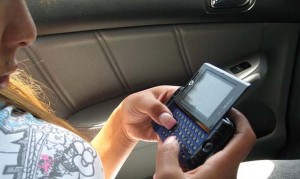Nearly a third of American 19-year-olds haven’t bothered to get a driver’s license, according to a new study, continuing a downward trend that finds fewer and fewer Millennials plugging into the American car culture.
Instead, suggest researchers at the University of Michigan Transportation Research Institute, (UMTRI), young people are substituting e-mail and text messaging for the traditional forms of socializing that would have required them to get a set of wheels to stay in contact with friends and family.
“Virtual contact reduces the need for actual contact,” suggested Michael Sivak, co-author of the new UMTRI study. “We found that the percentage of young drivers was inversely related to the availability of the Internet.”
The report is the latest in a series showing a steady decline in the number of teens getting their licenses. In 1983, only 12.7% of those aged 19 skipped that traditional rite of passage in the U.S. But the figure had nearly doubled, to 24.5% by 2008. The latest study looked at U.S. Census and Federal Highway Administration data to determine that in 2010 a full 30.5% of 19-year-olds didn’t yet have a license.
And the UMTRI report and other research by various automakers warns the trend is likely to continue.
“There’s a pretty significant shift in how people are viewing automobiles and transportation, in general,” John McFarland, senior manager of global marketing for Chevrolet, said in an interview last spring.
The trend is by no means limited to the United States. In fact, researchers first started raising the alarm in Japan where a growing number of young people have decided it’s easier to use mass transit – even crowded trains in cities like Tokyo – than sit stuck in endemic traffic jams. As a high-tech mecca, meanwhile, Japanese young people were among the first to shift to texting as a substitute for face-to-face socializing, experts suggest.
There may be other factors at play, however. Analyst Joe Phillippi, of AutoTrends Consulting, believes that while today’s cars might be more reliable than those sold to young Baby Boomers they don’t inspire the same level of passion and involvement.
“I used to always work on my car, changing the oil or the sparkplugs,” said Phillippi. “Today’s car, unless you’re a computer geek, you can’t work on it.”
The immediate impact for the auto industry remains a big question. Relatively few 19-year-olds buy new cars unless their parents offer one as a graduation present. But historical research shows that the passions consumers develop as teens has a big impact on what – or if – they buy later.
While most Americans eventually need to get a car because of the lack of mass transit this generally disinterest could mean that as they mature today’s teens will be less interested in buying a new vehicle – or may be content with basic econoboxes, rather than something more expensive and well-equipped, industry experts fear.
The one area recent research finds a connection between teens and the auto industry is with alternative-power green machines. But the middling demand for products like the Chevrolet Volt plug-in hybrid and Nissan Leaf battery-electric vehicle suggest that this passion for environmentally-friendly technology isn’t translating into sales – perhaps because of the high price of battery-based technology.
“There’s no silver bullet for Gen-Y,” said Clay Dean, head of advanced design at General Motors.
The maker showed off two concepts targeting Millennials – the Chevrolet Tru 140S and Chevy Code 130R – on the auto show circuit this year. And Dean hints that a low-priced model aimed at young buyers could reach market in the next several years.
The maker has been trying to pitch itself as Gen-Y-friendly in part, according to GM North America President Mark Reuss, because it believes the newer motorists are likely to have less of a memory of the poorly designed domestic models that sent Baby Boomers scurrying to imports.
“They’re less brand loyal,” according to Reuss, something the maker has tried to take advantage of with marketing efforts like the “kickflip” ad for the Chevrolet Sonic minicar that ran during the 2012 Super Bowl featuring pro skateboarder Ron Dyrdek.
GM is by no means the only maker hoping to get teens to put down their smartphones and put their hands on the steering wheel. Toyota specifically launched the Scion brand to target the market’s newest and youngest buyers. Models like the new iQ minicar have given it the lowest average age in the U.S. new car market – but at 35, that’s still targeting more car-friendly Gen-Xers.
And, if anything, it’s Boomers who make up more and more of the new car market. According to a survey by J.D. Power and Associates, those 50 and older generated 62% of all new vehicle sales in 2011, up from 39% in 2001.
That runs counter to traditional marketing wisdom that says the industry should focus on the next generation of buyers. But it’s also in line with the old automotive axiom that says, “You can sell a young person’s car to an old buyer but you can’t sell an old person’s car to a young buyer.”
If those young drivers are buying at all, something the new UMTRI survey suggests they may not be doing in large numbers.
If anything, they’re not even driving as much when they do have a car. An April study by the Frontier Group found that the average number of miles driven by those aged 16 to 34 dropped by 23% between 2001 and 2009 – to 7,900 miles annually. The national norm runs between 12,000 and 15,000 miles, depending on the study. And it suggests that while young people may be burning less rubber they’re running up a lot more texting charges.

